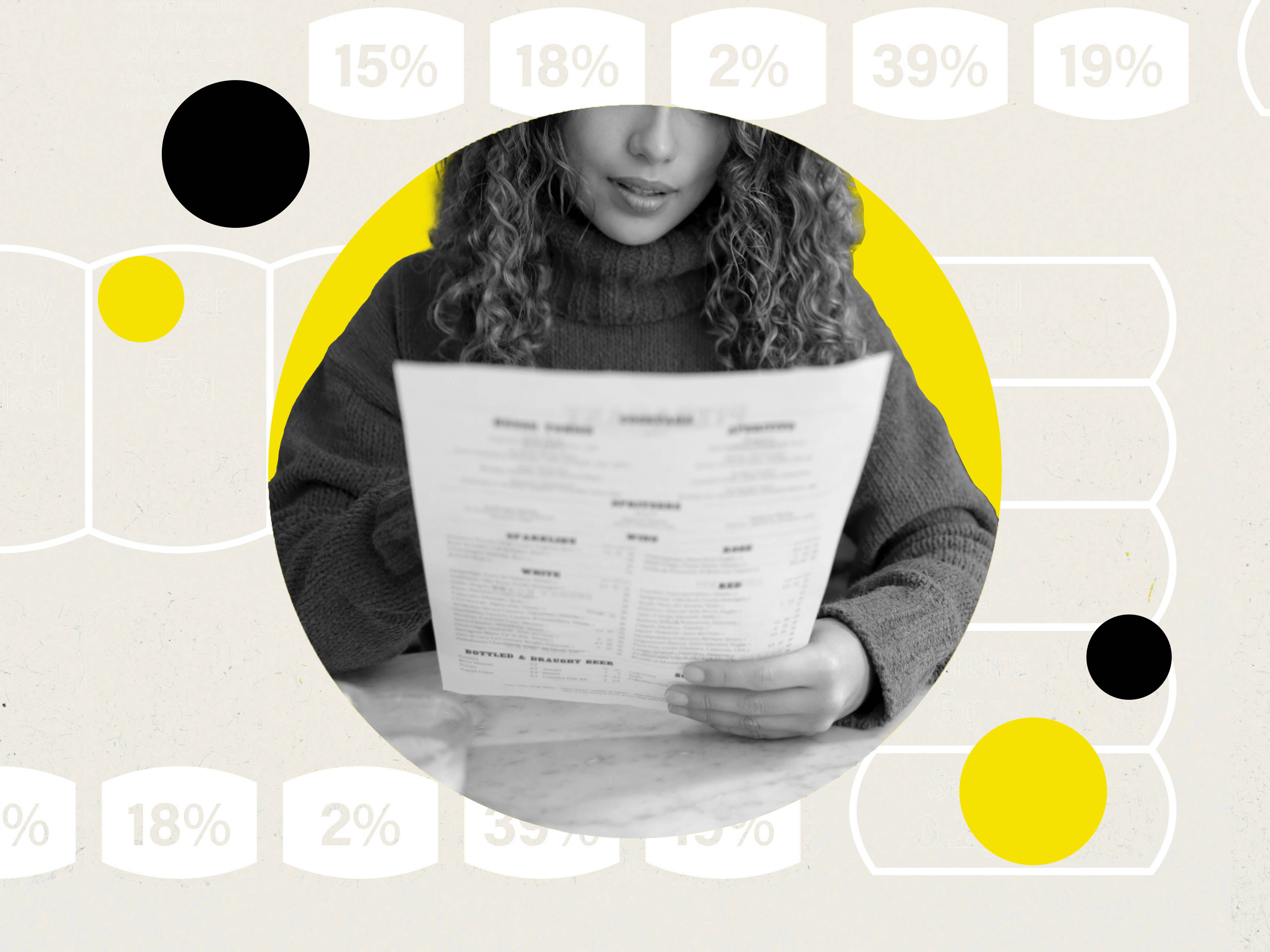Calorie counts on menus: What’s the real impact on diners and restaurants?
The government’s new scheme fails to address the real problem: the lack of preventative health care and education. Emma Henderson reports


You’ve booked the table, organised your friends and finally found a date that works for everyone, after rearranging three times. You’re shown to your table, the water is poured and you’re handed a menu. Every dish has the calorie counts listed on it. Right there in black and white staring right back at you. But, what if we don’t want to see it?
Well, there’s no choice now. From 6 April 2022, it’s compulsory for all restaurants, cafes, and takeaways in England that employ more than 250 people to include calorie counts on menus.
The aim of this initiative? It’s a bid to help reduce the amount of people diagnosed as obese in this country. But is publicly shaming people who are potentially vulnerable really the right way to go about it?
On the face of it, it sounds like useful information, but critics have condemned the move as dangerous and fear mongering, and expressed concern that it could plunge thousands more people into an eating disorder.
The government has completely blindsided the estimated 1.25 million people who are reported to have an eating disorder, according to charity Beat Eating Disorders. Public shaming could push these figures even higher.
The government has completely blindsided the estimated 1.25 million people who have an eating disorder
Eating out is supposed to be a pleasure. It is not our everyday. We’re not like the Italians or the French who survive on the cafe culture of dining out for any and almost every meal. Remember, this is dreary England. Most people’s everyday is eating most meals at home.
Those who oppose calorie labelling say that eating out isn’t to blame for obesity levels in the UK. According to data from Statista, from 2019, 40 per cent of people asked only dined out just once a month. For the rest of the month, on average 29 days, they eat at home. Only 8.5 per cent said they eat out more than once a week.
For those recovering from an eating disorder, or currently living with one, eating out is already difficult, and likely to be made even harder with this new law. For many, refuge is found in high street chains, where they know the menu and it doesn’t change too often.
Campaigners, including Beat, did manage to ensure that customers are allowed to ask for a menu without calories on it, but say this still singles people out. Along with this, the legislation would not apply in schools, which could have been enormously damaging for young people.
Beat also says there’s "little evidence to suggest that the legislation will be effective”, explaining: “A 2018 Cochrane review called Nutritional labelling for healthier food or non‐alcoholic drink purchasing and consumption found that there is only a small body of low-quality evidence supporting the idea that calorie counts on menus lead to a reduction in calories purchased. Although a more recent study found that calorie labelling in US fast food restaurants was associated with a 4 per cent reduction in calories per order, this reduction diminished over one year of follow-up, suggesting any small differences that may occur are not maintained."
Those who are worried about the labelling worry that only providing calories as the sole, fixed measure of health is also inaccurate. The amount of calories someone needs is dependent on many variables and isn’t a one size fits all approach.
Priya Tew, an eating order dietician says these new rules are “highly worrying”. “Putting calories on menus is not going to solve the obesity crisis. Usually people with an eating disorder have a fixation on tracking, weighing and measuring. People will likely choose low calorie meals, and won’t provide what they need, and will enforce this notion of having to track and count. Our bodies are not designed in this way. The body has to digest, absorb, and excrete. Just because you eat 100 calories, that doesn’t mean that’s what it takes in,” she says.
In my research, I struggled to really understand who the initiative is targeting. A restaurant, cafe or takeaway must have more than 250 employees to qualify, as if suggesting 249 or 158 or 17 employees makes the food any healthier.
To employ 250 staff is a lot. That excludes practically all small businesses. That only really leaves well known high street chain restaurants, such as PizzaExpress, Wahaca, Franco Manca and Wagamamas. It also includes fast food takeaways, such as Subway and Burger King. McDonald’s and KFC already include calorie counts on their menus, and have done since 2011. McDonald’s now only needs to amend this to include calorie counts for all the customisable aspects of its burgers.
McDonald’s and KFC already supplies the calorie counts of its food, and has done so since 2011
Another household name that’s also been ahead of the game is Wetherspoon. The cheap pub chain has included calorie counts on its food menus for five years, and its drink menus for three. Wetherspoon said the reason behind this was to give the customer an informed choice.
Elsewhere on the high street, Côte Brasserie is redesigning its space, bringing in a new head chef and a new menu. The new menu, which isn’t in reaction to the legislation, “will see 38 per cent of main dishes contain less than 700 calories to offer diners a real choice”, Côte said in an announcement, although it says it hasn’t swapped in lower-calorie ingredients or decreased portion sizes to reach this goal.
Part of the new menu will also see “a number of options to enable diners to choose a two-course meal for 1,000 calories, as well as being able to enjoy three-courses for 1,000 calories as well”. Courses are usually grouped together by price, rather than calories, so it’s a troubling thought. It feeds the “watching what you eat” mentality, suggesting you can only have these courses if they’re under the 1,000 calorie mark.
The concept of offering diners a less calorific meal is not a new one, though. A decade ago, PizzaExpress launched its Leggera pizza. You remember the one: it literally cut a hole in the middle of the pizza and replaced it with rocket leaves, and then claimed it had reduced the calories by a third. Well, yes, as you’re getting a third less pizza. The chain is back again with a new idea, launching a range of pizza wraps, which each has less than 600 calories.
There is an exception to the new calorie labelling rules to watch out for. Any meals deemed as “specials”, which are not on the menu for more than 30 days, do not have to show the calorie count.
While some restaurants were already sharing calorie counts or offering dishes marketed as lower-calorie, it’s now going to be rolled out across the board. Sure, you can ask for a menu without calorie counts, but what if that menu has been lost or damaged, or for whatever reason you don’t feel comfortable asking for it? What if it doesn’t exist?
One restaurant chain pointed out that being transparent about the calories is only “one part of the story”. Wahaca co-founder Mark Selby tells me that this focus on calories rather than nutrition, fibre and seasonality (to name just a few other important elements) can be “misleading”. Tew agrees: “We don’t want people to only look at calories. Instead, food should be about pleasure.”
Research from a survey Beat carried out last year of 1,118 people showed that a huge 93 per cent think the introduction of calorie labelling would be either “negative or very negative” for people with eating disorders, while 83 per cent of people did not support the new initiative.
This is not to say there isn’t an issue with obesity in this country. From the most recent government stats, in 2017 nearly two-thirds of adults (63 per cent) in England were classed as being overweight or obese. This is costing the country £6.1bn a year, which is estimated to rise to £9.7bn by 2050, but if we can prevent the problem, that number could be greatly reduced. Calories are only one part of the story. To only focus on calories means you forget about other thigns such as nutrition, fibre and seasonality
Calories are only one part of the story. To only focus on calories means you forget about other thigns such as nutrition, fibre and seasonality
Yet this government initiative is not likely to solve the crisis; 84 per cent of those surveyed by Beat agreed with that sentiment. They thought calorie labelling could be introduced in a way that doesn’t pose risks to people living with eating disorders.
So, what are these alternative ideas? Preventative healthcare and more education are both key. As most of our meals are eaten at home, teaching the next generation how to cook healthy meals with whole, fresh and seasonal ingredients couldn’t be more important. And with the rise in the cost of living, even fewer people are likely to be eating out. Instead, they’ll be looking for more affordable ways to feed themselves and their families.
According to research carried out by Ocado for its School of Magical Mealtimes campaign, more than half of children do not learn the basics of cooking at school. In 2015, food tech as a subject was dropped from the A level syllabus, which prevents any further education in food, and tells younger children at GCSE level or below that it’s not a useful skill or a career option. Despite that, the study also showed that eight out of 10 parents believe cooking from scratch with their child can encourage healthier eating habits.
Not all parents or guardians are confident in the kitchen, nor do all of them have the flexibility with work to be at home for evening meals. The rise in living costs will likely affect how people cook at home, too. Anti-poverty food campaigner Jack Monroe has written about how to a manage a healthy weekly food shop under £20.
Selby agrees that learning the basics when you’re young is important. “Tackling it at an early age is the best education and can help change habits for years. The new rules coming into restaurants feels a little bit tokenistic.”
Other areas that should be targeted are portion sizes, such as snacks like packets of crisps, suggests Tew. And we need to learn to listen to ourselves. It’s important to “really get people to tune into their body and fullness cues”. Besides when our bodies are actually telling us we need food, we can also feel hunger when we’re bored, stressed or lonely. It’s also about “encouraging people to move bodies in ways that feel good and are not punishing”, Tew adds.
Eating out is a joy, an occasion we look forward to, not having to wash the dishes or clear up, or to shop or even turn on the cooker, to socialise, to try new foods. It should not be a place to be shamed, to fear, especially not vulnerable people. Instead, through teaching young people cooking skills and about nutrition, we can make our own informed choices.
For anyone struggling with the issues raised in this article, eating disorder charity Beat’s helpline is available 365 days a year on 0808 801 0677.NCFED offers information, resources and counselling for those suffering from eating disorders, as well as their support networks. Visiteating-disorders.org.uk or call 0845 838 2040.
Join our commenting forum
Join thought-provoking conversations, follow other Independent readers and see their replies
Comments



Bookmark popover
Removed from bookmarks